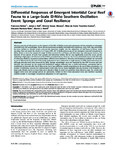Differential Responses of Emergent Intertidal Coral Reef Fauna to a Large-Scale El-Niño Southern Oscillation Event: Sponge and Coral Resilience
| dc.contributor.author | Kelmo, F | |
| dc.contributor.author | Bell, JJ | |
| dc.contributor.author | Moraes, SS | |
| dc.contributor.author | Gomes, RDCT | |
| dc.contributor.author | Mariano-Neto, E | |
| dc.contributor.author | Attrill, MJ | |
| dc.date.accessioned | 2017-04-27T13:01:34Z | |
| dc.date.available | 2017-04-27T13:01:34Z | |
| dc.date.issued | 2014 | |
| dc.identifier.issn | 1932-6203 | |
| dc.identifier.issn | 1932-6203 | |
| dc.identifier.other | ARTN e93209 | |
| dc.identifier.uri | http://hdl.handle.net/10026.1/9138 | |
| dc.description.abstract |
There is a paucity of information on the impacts of the 1997-8 El Niño event and subsequent climatic episodes on emergent intertidal coral reef assemblages. Given the environmental variability intertidal reefs experience, such reefs may potentially be more resilient to climatic events and provide important insights into the adaptation of reef fauna to future ocean warming. Here we report the results of a 17-year (1995-2011) biodiversity survey of four emergent coral reef ecosystems in Bahia, Brazil, to assess the impact of a major El Niño event on the reef fauna, and determine any subsequent recovery. The densities of two species of coral, Favia gravida and Siderastrea stellata, did not vary significantly across the survey period, indicating a high degree of tolerance to the El Niño associated stress. However, there were marked decreases in the diversity of other taxa. Molluscs, bryozoans and ascidians suffered severe declines in diversity and abundance and had not recovered to pre-El Niño levels by the end of the study. Echinoderms were reduced to a single species in 1999, Echinometra lucunter, although diversity levels had recovered by 2002. Sponge assemblages were not impacted by the 1997-8 event and their densities had increased by the study end. Multivariate analysis indicated that a stable invertebrate community had re-established on the reefs after the El Niño event, but it has a different overall composition to the pre-El Niño community. It is unclear if community recovery will continue given more time, but our study highlights that any increase in the frequency of large-scale climatic events to more than one a decade is likely to result in a persistent lower-diversity state. Our results also suggest some coral and sponge species are particularly resilient to the El Niño-associated stress and therefore represent suitable models to investigate temperature adaptation in reef organisms. | |
| dc.format.extent | e93209-e93209 | |
| dc.format.medium | Electronic-eCollection | |
| dc.language | en | |
| dc.language.iso | eng | |
| dc.publisher | Public Library of Science (PLoS) | |
| dc.subject | Animals | |
| dc.subject | Anthozoa | |
| dc.subject | Biodiversity | |
| dc.subject | Brazil | |
| dc.subject | Coral Reefs | |
| dc.subject | Ecosystem | |
| dc.subject | El Nino-Southern Oscillation | |
| dc.subject | Environment | |
| dc.subject | Porifera | |
| dc.title | Differential Responses of Emergent Intertidal Coral Reef Fauna to a Large-Scale El-Niño Southern Oscillation Event: Sponge and Coral Resilience | |
| dc.type | journal-article | |
| dc.type | Article | |
| plymouth.author-url | https://www.ncbi.nlm.nih.gov/pubmed/24675785 | |
| plymouth.issue | 3 | |
| plymouth.volume | 9 | |
| plymouth.publication-status | Published online | |
| plymouth.journal | PLoS ONE | |
| dc.identifier.doi | 10.1371/journal.pone.0093209 | |
| plymouth.organisational-group | /Plymouth | |
| plymouth.organisational-group | /Plymouth/Faculty of Science and Engineering | |
| plymouth.organisational-group | /Plymouth/Faculty of Science and Engineering/School of Biological and Marine Sciences | |
| plymouth.organisational-group | /Plymouth/PRIMaRE Publications | |
| plymouth.organisational-group | /Plymouth/REF 2021 Researchers by UoA | |
| plymouth.organisational-group | /Plymouth/REF 2021 Researchers by UoA/UoA07 Earth Systems and Environmental Sciences | |
| plymouth.organisational-group | /Plymouth/Users by role | |
| plymouth.organisational-group | /Plymouth/Users by role/Academics | |
| dc.publisher.place | United States | |
| dcterms.dateAccepted | 2014-02-28 | |
| dc.identifier.eissn | 1932-6203 | |
| dc.rights.embargoperiod | Not known | |
| rioxxterms.versionofrecord | 10.1371/journal.pone.0093209 | |
| rioxxterms.licenseref.uri | http://www.rioxx.net/licenses/all-rights-reserved | |
| rioxxterms.licenseref.startdate | 2014 | |
| rioxxterms.type | Journal Article/Review |


